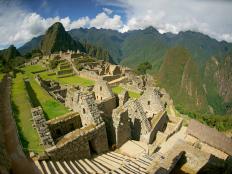New UNESCO World Heritage Sites You Can Visit
UNESCO World Heritage added 19 new sites for 2018, and although each one is worth writing about, here are our top 10 picks for places to add to your ever-growing travel bucket list. (Plus see our 10 favorite sites added in 2016.) Getting to some of these spots isn’t easy, but few things that are worthwhile ever are.
Sansa, Buddhist Mountain Monasteries, Korea, 2018
Seven Buddhist temples, dating between the seventh and ninth centuries, are included in the World Heritage designation. All are still in use by monks and encompass Beopjusa, Tongdosa, Buseoksa (pictured), Daeheungsa, Seonamsa, Magoksa and Bongjeongsa. Among the shared commonalities are remote mountain locations with beautiful scenery, along with four buildings — a dorm, pavilion and lecture and prayer halls — surrounding an open courtyard. Beopjusa is one of the best known of the temples. It’s tucked away in Songnisan National Park and notable for the bronze Buddha that towers over the courtyard. Not only can guests visit, but the temple even offers a temple stay program. Guests can stay at Seonamsa too, which requires a half-hour walk along a peaceful stream before reaching the actual temple. In fact, travelers can overnight at most of the temples, and visit the rest.
Naumburg Cathedral, Germany, 2018
Near Leipzig in East Germany, Naumburg Cathedral has landed on this year’s list thanks to its exemplary Romanesque and Gothic styles dating back to the Middle Ages. Among its distinctive features are two Gothic choirs and 12 life-size statues depicting the cathedral’s founders. An unknown craftsman, dubbed the Naumburg Master, is credited with creating the medieval masterpieces, the most famous of which is Uta von Ballenstedt, or Uta von Naumburg, whom it’s believed the Evil Queen in "Snow White and the Seven Dwarfs" is modeled after. At the very least, there’s no denying the resemblance.
Victorian Gothic and Art Deco Ensembles, Mumbai, 2018
In the 19th and 20th centuries, Mumbai, back then called Bombay, experienced an urban planning boom that added striking Victorian and Art Deco buildings to the city’s landscape. Mumbai University, the Maharashtra Police Headquarters and Bombay High Court are classic examples of the Victorian style, popular in the 19th century. But the Chhatrapati Shivaji Maharaj Terminus (pictured), the city’s main train station, is arguably the pinnacle of Mumbai’s Victorian Gothic architecture. Art Deco took hold in the 20th century, and many buildings were built in this style, especially along the tony residential section of Marine Drive. Although Indo Deco is more apt, thanks to the heavy incorporation of Indian design. Elsewhere in the city, the Cricket Club of India and Eros and Regal Cinemas are standout examples.
Caliphate City of Medina Azahara, Spain, 2018
As a caliphate, meaning under Muslim rule, Medina Azahara served as the capital of Muslim Spain for a brief time period in the 10th century. The city contained a palace, government offices, roads, bridges, aqueducts, gardens and more, but it lasted less than 100 years before a civil war destroyed it. The remains of the once-wealthy city are just five miles from Cordoba in Andalusia, and guided tours provide a glimpse into the palace, homes and even a mosque-cathedral. Rediscovered in the early 20th century, it’s estimated that only 10 percent of the city, spread across about 300 acres, has been restored so far. A fairly new museum provides additional information about the history, artifacts and way of life.
Fanjingshan, China, 2018
As one of three natural sites on this year’s list, Fanjingshan, or Fanjing Mountain, is part of the unspoiled Wuling Mountain Range in southwest China. The mountain may have formed 65 million years ago, and thanks to its remote location, Fanjingshan is still home to ancient plant and animal life. Current estimates in terms of species include almost 2,000 plants, 191 birds, 68 mammals and 34 amphibians. Many are endangered, such as the golden snub-nosed monkey and the Chinese giant salamander. There are even a number of Buddhist temples perched among the peaks, which can be reached by huffing up almost 9,000 ancient steps, or, better yet, by taking a cable car.
Al-Ahsa Oasis, an Evolving Cultural Landscape, Saudi Arabia, 2018
One can only imagine the enormous relief ancient desert trekkers must have felt upon encountering Al-Ahsa Oasis, which today is not just the largest oasis in Saudi Arabia, but actually the largest oasis in the world. Surrounded by sand on the country’s eastern side, it counts about 2.5 million date palm trees across 30,000 acres. But it’s not all palm trees. There are also dozens of cold and hot springs, canals, gardens, archeological sites and historic buildings. It’s believed the earliest inhabitants date back to prehistoric days; today the region is home to cities, towns and a five-star hotel.
Hidden Christian Sites in the Nagasaki Region, Japan, 2018
Portuguese missionaries introduced Christianity to Japan in the 15th century, but a backlash banned the religion from 1614 to 1873. Most of the 12 places on the UNESCO list are tiny villages on tiny remote islands throughout Kyushu Island in the Nagasaki region, where the hidden Christian communities lived. These include Sakitsu Village in Amakusa (pictured) and Ono Village in Sotome. The other two sites are the ruins of Hara Castle, a key battleground site of a massive Christian rebellion during the country’s two-century ban on Christianity, after which Japan’s surviving Christians went into hiding, if they weren’t already, in order to practice their faith. Oura Church represents the partial end of the hidden period, with some communities emerging and publicly declaring their Christianity at the site —even though the ban was still in effect. It’s also Japan’s oldest wooden Gothic church.
Ivrea, Industrial City of the 20th Century, Italy, 2018
The pretty town of Ivrea tends to fly under the radar, even though it’s less than a two-hour drive west from Milan and just north of Turin. It’s known for its famous Carnival, in particular, the fierce Battle of the Oranges originating in the 12th century. And yes, it involves the townspeople pelting each other with oranges. But Ivrea has landed on this year’s UNESCO list not because of oranges, but because of its role as the center for Olivetti typewriters in the 20th century. UNESCO recognizes the impact that Adriano Olivetti had on industrial architecture, as he’s credited with factoring both aesthetics and quality of life into his urban planning design. This style of architecture reflected the Community Movement, a political organization Olivetti founded. At Ivrea’s peak, the small city contained factories, housing and other structures to serve the community’s needs — not unlike today’s major tech campuses in California.
Tehuacán-Cuicatlán Valley: Originary Habitat of Mesoamerica, Mexico, 2018
Tehuacan-Cuicatlan Valley spans Central Mexico, covering parts of both Puebla and Oaxaca. The partially desert landscape is home to a vast array of cacti; the agave species originated here, and yucca plants also abound. UNESCO also recognizes the region for containing the most biodiversity in North America, encompassing endangered birds, bats and yes, even cacti.
Ancient City of Qalhat, Oman, 2018
The ancient city of Qalhat reigned between the 11th and 15th centuries and served as an important trade port city and early capital. In fact, famed explorer Marco Polo once passed through, writing about the Indian ships that docked in Qalhat’s harbor. Other travelers wrote about the city’s bustling bazaars and grand mosques, while archeology remains include walls, ramparts and cemeteries. It’s suspected that a devastating earthquake and subsequent Portuguese invasion eventually toppled Qalhat, now little more than crumbled ruins in the arid landscape. However, the sand-colored Bibi Maryam mausoleum (pictured) is the most intact structure, and easily seen from the highway. An archeological dig to uncover more is underway as of this writing.
Sanganeb Marine National Park and Dungonab Bay/Mukkawar Island Marine National Park, Sudan, 2016
This inclusion encompasses Sanganeb Marine National Park and Dungonab Bay/Mukkawar Island Marine National Park. Both are found off the coast of Sudan in the Red Sea, and represent every scuba diver’s dream. The parks are renowned for their coral reefs, plus they’re packed with marine life, from dolphins and turtles to sharks and tropical fish. This protected area is also home to a large dugong population, a manatee relation that’s distinguished by its fluked whale-like tail.
Gorham's Cave Complex, Gibraltar, United Kingdom, 2016
You’ve likely heard of the Rock of Gibraltar, known since ancient Greek times as part of the 12 impossible tasks Hercules had to perform. It’s located on the Gibraltar peninsula in Spain near Morocco, which has been a British territory since the early 18th century. Even more fascinating is that the limestone caves on the rock’s eastern side were once home to Neanderthals for at least 100,000 years. Four caves comprise Gorham’s Cave Complex, where archeologists have uncovered rock carvings, ornamental feathers and proof of a plant- and meat-based diet. The caves are also significant because they’re considered one of the last known Neanderthal dwellings, whose inhabitants lived there as recently as 28,000 years ago.
Hubei Shennongjia, China, 2016
Shennongjia Nature Reserve, a subtropical Chinese forest in the Hubei province, is home to one of China’s most biodiverse regions. Here you can find rare animal species, including the Asian black bear, clouded leopard and golden snub-nosed monkey. It’s not easy getting to the reserve, and much of it is inaccessible, but there are tourist-friendly areas worth making the multi-hour trek. You’ll find hiking trails (keep an eye out for the Chinese equivalent of Big Foot) and the impressive Shennong Altar. If you’re up for it, climb the long flight of stairs for a close-up view of the giant half-human, half-bull statue. As an active shrine, don’t be surprised to see locals paying their respects here.
Archaeological Site of Ani, Turkey, 2016
Ancient ruins are often associated with Italy or Greece; in fact, the Archaeological Site of Philippi in Greece made this UNESCO list as well. But the ruins in Ani, Turkey, literally a stone’s throw from Armenia, are fascinating because its history as a major medieval center isn’t widely known. The city existed from the 10th to 17th centuries; at least 100,000 lived here during its height in the 11th century, when it was known as "The City of 1,001 Churches." As an in-demand locale, it was conquered endless times throughout the centuries by everyone from the Ottomans (more than once) and Mongols to the Byzantines and Armenians. (Relations with the latter have long been tense, and the border has remained closed since 1993.) In fact, events in modern history have made it impossible for anyone to visit Ani until this past decade. Those who make the trek will find some of the ruins remarkably intact, considering centuries of war, earthquakes and vandalism. Between few tourists and the rugged, unpopulated landscape, it’s easy to visualize what life might have been like so long ago.
Pampulha Modern Ensemble, Brazil, 2016
This former complex, consisting of a church, casino, ballroom, golf course and yacht club, were all part of a grander scheme for a planned community in Belo Horizonte, Brazil. Centered around man-made Pampulha Lake, the complex is a stunning example of modern architecture in the early 1940s. It was also one of architect Oscar Niemeyer’s first major projects; he went on to play a significant role in Brazil’s modern architecture movement. (It’s worth noting that famed modern architect Le Corbusier greatly influenced Niemeyer’s work; he also made this UNESCO list.) Though Pampulha no longer functions as a community, you can visit the site, along with the Pampulha Art Museum, located in the former casino.
Ennedi Massif, Chad, 2016
UNESCO added the Ennedi Massif section of the Ennedi Plateau, part of the Sahara Desert in Chad, for two reasons. The first is the wind-ravaged landscape, where towering canyons and plunging valleys are dotted by otherworldly sandstone formations. The second is the area’s abundance of petroglyphs, or rock art, deemed to be one of the largest examples in the Sahara. Much of the artwork dates back thousands of years. Niola Doa (dancing maidens) is one of the oldest and most famous sites. The hardy few that venture this far will encounter life-size depictions of women covered in intricate designs and jewelry; the complexity of it makes the mind reel to think it’s about 7,000 years old.
Stećci Medieval Tombstone Graveyards, Bosnia and Herzegovina, Croatia, Serbia and Montenegro, 2016
Stećci, or medieval tombstones, are largely found throughout Bosnia and Herzegovina, and to a lesser extent in the bordering areas of Croatia, Serbia and Montenegro. UNESCO chose 28 sites for their elaborate engravings and other regional distinctions. Most of the cemeteries date between the 12th and 16th centuries, and a surprising number of limestone tombstones are well preserved, showing off inscriptions and designs that favored animals, flowers, crosses and more. Radimlja in Herzegovina contains some of the best examples of stećci thanks to a large number in a variety of shapes and sizes. Some of the most impressive tombs contain carvings of knights with bows and arrows — exactly what you’d hope to find from the Middle Ages.
Mistaken Point, Canada, 2016
Mistaken Point supposedly earned its name after countless sailors mistakenly navigated there. However, UNESCO added this rugged Newfoundland coastal area for its ancient fossils. And by ancient, this part of Canada has quietly concealed one of the oldest examples on record of large, complex life forms, which have been traced back 580 million years. The remains of these deep ocean dwellers were buried and preserved by volcanic ash; fossils found before this era reflect microscopic creatures. The Edge of Avalon Interpretive Centre, part of the Mistaken Point Ecological Reserve, leads seasonal hikes to Mistaken Point since visitors aren’t allowed without an official guide.
Archaeological Site of Nalanda Mahavihara (Nalanda University), Bihar, India, 2016
Nalanda University holds the distinction of one of the oldest universities in the world. Founded as early as the 3rd century B.C., it lasted until around the 13th century, when invaders destroyed it. It functioned as a Buddhist center and a place of higher education, where, in addition to Buddhist teachings, students are said to have learned everything from medicine and philosophy to astronomy and math. At its peak as many 10,000 students attended, and came as far away as Turkey and Korea (which explains evidence of dorms). The campus contained classrooms, temples, a library and meditation halls. Tourists can visit the ancient ruins, as well as the Nalanda Archaeological Museum, where objects excavated from the site are on display.
The Persian Qanat, Iran, 2016
Qanat are irrigation tunnels that have carried much-needed water to Iran’s desert regions for more than 3,000 years. It’s estimated that more than 30,000 qanat are still in use today; UNESCO chose 11 as ideal representations of the ancient system, such as containing a rest area for laborers to watermills and reservoirs.


